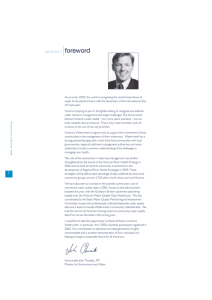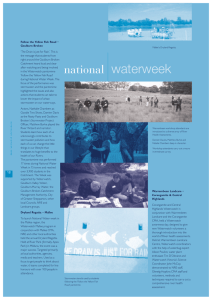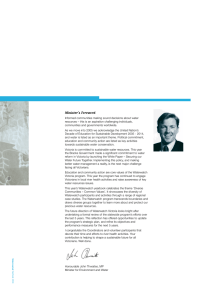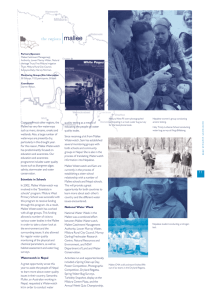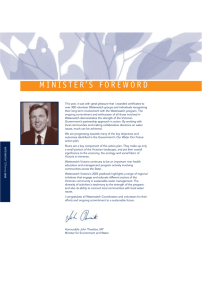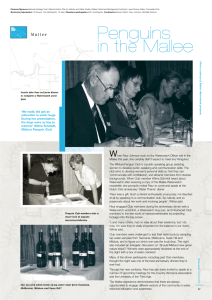watery 2007/08 Mallee •
advertisement
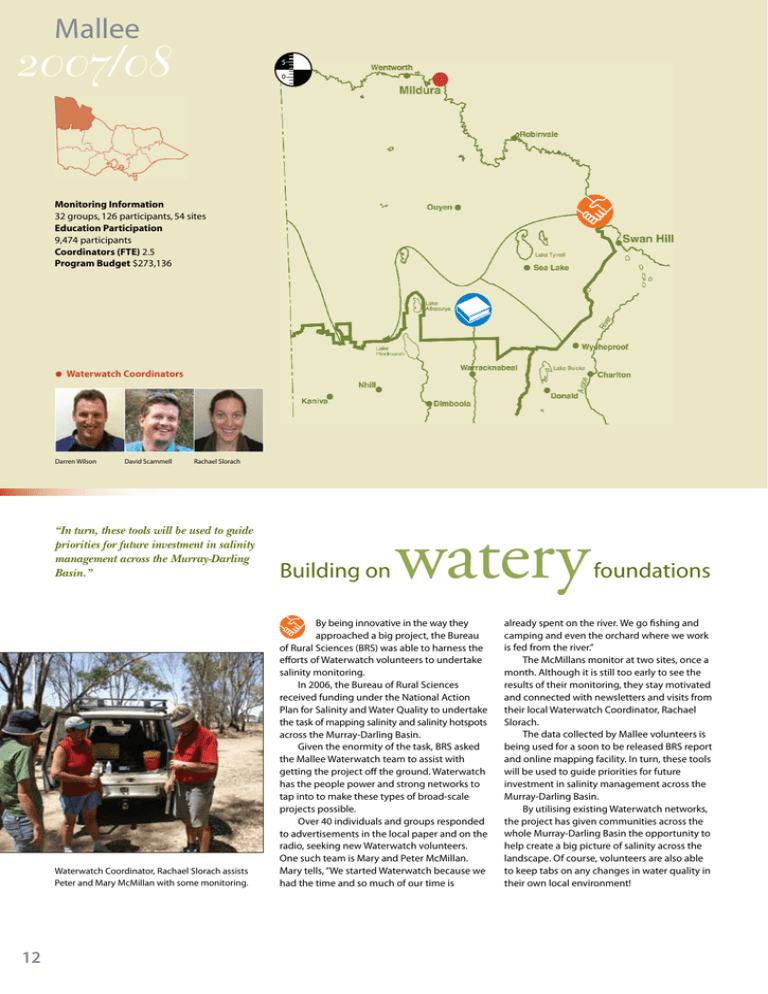
Mallee 2007/08 Monitoring Information 32 groups, 126 participants, 54 sites Education Participation 9,474 participants Coordinators (FTE) 2.5 Program Budget $273,136 • Waterwatch Coordinators Darren Wilson 12 David Scammell Rachael Slorach watery “In turn, these tools will be used to guide priorities for future investment in salinity management across the Murray-Darling Basin.” Building on Waterwatch Coordinator, Rachael Slorach assists Peter and Mary McMillan with some monitoring. By being innovative in the way they approached a big project, the Bureau of Rural Sciences (BRS) was able to harness the efforts of Waterwatch volunteers to undertake salinity monitoring. In 2006, the Bureau of Rural Sciences received funding under the National Action Plan for Salinity and Water Quality to undertake the task of mapping salinity and salinity hotspots across the Murray-Darling Basin. Given the enormity of the task, BRS asked the Mallee Waterwatch team to assist with getting the project off the ground. Waterwatch has the people power and strong networks to tap into to make these types of broad-scale projects possible. Over 40 individuals and groups responded to advertisements in the local paper and on the radio, seeking new Waterwatch volunteers. One such team is Mary and Peter McMillan. Mary tells, “We started Waterwatch because we had the time and so much of our time is foundations already spent on the river. We go fishing and camping and even the orchard where we work is fed from the river.” The McMillans monitor at two sites, once a month. Although it is still too early to see the results of their monitoring, they stay motivated and connected with newsletters and visits from their local Waterwatch Coordinator, Rachael Slorach. The data collected by Mallee volunteers is being used for a soon to be released BRS report and online mapping facility. In turn, these tools will be used to guide priorities for future investment in salinity management across the Murray-Darling Basin. By utilising existing Waterwatch networks, the project has given communities across the whole Murray-Darling Basin the opportunity to help create a big picture of salinity across the landscape. Of course, volunteers are also able to keep tabs on any changes in water quality in their own local environment! Monitoring makes a day of it When Rae and Peter Knyvett of Mildura first responded to an advertisement in the local newspaper seeking volunteers for water quality monitoring, little did they know that they would soon be responsible for collecting data from some true Waterwatch ‘outposts’. Peter said, “We like going bush and have the time to do the monitoring.” Rae adds, “Peter is a keen fisherman as well, but our monitoring days are pretty full so he hasn’t managed any fishing yet!” In fact, the 300 km round trip to their five monitoring sites at Lindsay and Mulcra Islands and Toupnein Creek near the South Australian border takes nearly eight hours, travelling through some very rugged and remote but beautiful country. So rugged are some of the tracks that Peter was compelled to record in his field notes recently, “At long last the road grader has been through!” Both ex-teachers and previously involved in Saltwatch, Rae and Peter see the importance of regularly and accurately collected data and know that their contribution is important in monitoring the success of numerous Mallee Catchment Management Authority projects, such as the installation of bollards to prevent vehicle access to riverbanks. Peter and Rae look forward to sharing results with other Mallee monitors through newsletters and training days. But their monitoring has also given them the opportunity to travel off the main road, discover some ‘new tracks’ and introduce some friends to the remote, beautiful country they visit every month. Little Students are keen to see the macroinvertebrates. “There is a whole other world in the water and there is no better way to educate than to do it by fun.” Rae Knyvett does a phosphate test. “Peter and Rae knew that their contribution is important in monitoring the success of numerous CMA projects.” critters travel far When the Mallee Waterwatch trailer visited Hopetoun, it had on board some important cargo not usually seen in the dry environs of the southern Mallee. Macroinvertebrates from King’s Billabong in Mildura made the two-hour trip south for a Southern Mallee Junior Landcare interactive workshop. With the trailer visiting, local Landcare coordinator Heather Drendel took the opportunity to focus on what lives under the water and what lives around the edge of waterways. She describes, “There is a whole other world in the water and there is no better way to educate than to do it by fun.” Junior Landcarers got stuck into a range of water quality tests, set up some experiments to observe the response of growing bean seeds with water of varying degrees of salinity, identified different macroinvertebrates and water plants and enjoyed a new animated film about salinity, called “Fresh and Salty”, created for students by Wimmera Community Waterwatch. As Fran Lynch, a teacher at Hopetoun Primary School said, “Without the trailer, the kids would never get to see macroinvertebrates. There are no waterways near us that have macros because they’ve all dried up, so naturally the kids were really excited.” Although based in Mildura, the trailer makes regular trips to all corners of the Mallee, giving Waterwatchers and Landcarers the opportunity to see some new and different things, regardless of where they are in the catchment. Partners and Sponsors of the Mallee Waterwatch Program Mallee Catchment Management Authority, Lower Murray Water, National Action Plan for Salinity and Water Quality, Bureau of Rural Sciences, Sunraysia Marine, Kulkyne Kampers. 13
